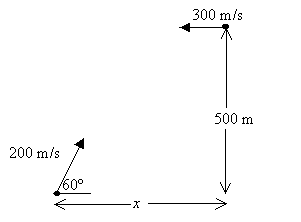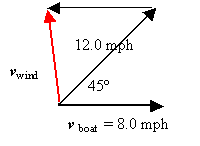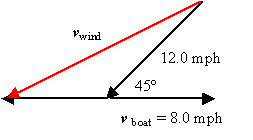ax = [(10m/s) - 0]/[(2 s) - 0] = 5 m/s2, from t = 0 to t = 2 s, and ax = 0 from t = 2 s to t = 4 s..
In the y-direction ay = constant.
a. We find the time
From t = 0 to t = 2 s: x = x0 + vx0t + 1/2ax(2 s)2,
from t = 2s to t = t s: x = (10 m/s)(t - 2 s)
20 m = 0 + 0 + 1/2(5 m/s2)(2 s)2 + (10 m/s)(t - 2 s), solving the equation we have t = 3 s.
b. We find ay from
y = y0 + vy0t + 1/2ayt2,
0 = 9.0 m + 0 + 1/2ay( 3 s)2, ay = -2 m/s2.
v4y = 0 + (-2 m/s2)(4 s ) = -8 m/s.
c. From t = 0 to t =2 s, we have x = 1/2(5 m/s2)t2, and y = 9.0 m + 1/2( -2 m/s2)t2; eliminating t, we have y = (9.0 -0.4x)
From t = 2 s and later, we have x = 10 m + (10 m/s)(t - 2 s), and y = 9.0 m + 1/2( -2 m/s2)t2
Eliminating t we have
y = 8- 0.2 x - 0.01x2

b. Relative to the fisherman, the motion of the spyglass is projectile motion with v0 = 4.0 m/s and q0 = 0?. Find the range of the projectile motion.
Find the time that the spyglass lands.
y = 1/2gt2
15 m = 1/2(9.8m/s2)t2, which gives t = 1.75 s.
Find the range.
x = vxt = (4.0 m/s)(1.75s) = 7.00m.
h = y0 + vy0t - 1/2gt2;
= 0 + (30 m/s)(sin60º)(4.0 s) - 1/2(9.8m/s2)(4.0 s)2
= 25.5 m.
b. Find the maximum height of the ball.
v2 = v02 - 2gy;
0 = [(30 m/s)(sin60?)]2 - 2(9.8m/s2)ymax, ymax = 34.3 m.
c. Find the impact speed.
vy = (30 m/s)sin60º -(9.8 m/s2)(4.0 s) = -13.2 m/s (down), and vx = (30 m/s)cos60º = 15 m/s.
v = [vx2 + vy2]1/2 = [(-13.2 m/s)2 + (15 m/s)2]1/2 = 20.0 m/s.
y = y0 + vy0t - 1/2gt2;
500 m = 0 + (200 m/s)sin60?t - 1/2(9.8m/s2)t2, t = 3.17s, 32.1 s.
The horizontal speed of the shell with respect to the plane is v = (200 m/s)cos60? + 300 m/s = 400 m/s.
x1 = vxt = (400 m/s)(3.17 s) = 1.267 km.
x2 = vxt = (400 m/s)(32.1 s) = 12.84 km..
We get two answers: 1.267km when the plane is closer (shell ascends), and 12.84 km when the plane is farther away. (shell descends)

vwind = v - vboat.
vwind, = [(12.0 mph)cos45? - (8.0 mph)]i + [(12.0 mph)sin45? - 0]j
= (0.49 mph)i + (8.5 mph)j
vwind = [(0.49 mph)2 + (8.5 mph)2]1/2 = 8.51 mph
q = tan-1(85.1 mph/0.49 mph) = 86.7? (northwest)


b. vwind = v - vboat.
vwind, = [(-12.0 mph)cos45? - (8.0 mph)]i - [(12.0 mph)sin45? - 0]j
= (-16.5 mph)i - (8.5 mph)j
vwind = [(-16.5 mph)2 + (8.5 mph)2]1/2 = 18.6 mph
q = tan-1(8.5 mph/16.5 mph) = 27.3? (northeast)
R = vcat02sin2q0/g = vcat0cosq0t;
(4.0 m/s)2sin2(30?)/(9.8m/s2) = (4.0 m/s)cos30?t, t = 0.41 s.
Find the distance.
d = vcat0cosq0t - vmouset = (4.0 m/s)cos30?(0.41 s) - (1.5 m/s)(0.41 s) = 0.81m.